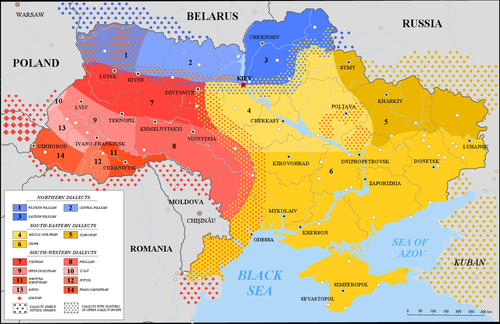Dniestrian Ukrainian dialect

The Dniestrian Ukrainian dialect (Ukrainian: Наддністрянський говір, romanized: Naddnistrianskyi hovir), Opillia dialect (Ukrainian: опільський говір) or Galician dialect (Ukrainian: галицький говір) is a dialect of Ukrainian spoken in the western part of Ukraine. The Dniestrian Ukrainian dialect is typically grouped together with other southwestern dialects of Ukrainian.[1]
Main features
[edit]Phonetics
[edit]Main phonetic features which distinguish the Dniestrian dialect from other varieties of Ukrainian are:
- transition of the vowel [a] (derived from old [a], [ɛ̃]) into [e], [ɛ], [ɪ] following palatalized consonants: гарьичий [ɦɐˈrʲet͡ʃei̯], дєкувати [ˈdʲɛkʊʋɐte], сажі [ˈsaʒɪ], compared to standard Ukrainian - гарячий [ɦɐˈrʲat͡ʃei̯], дякувати [ˈdʲakʊʋɐte] , сажа [ˈsaʒɐ];
- different formation of personal forms in some verbs, for example любˈять [ˈlʲubjɐtʲ], ловˈять [ˈlɔʊ̃jɐtʲ] instead of Standard Ukrainian люблять [ˈlʲublʲɐtʲ], ловлять [ˈlɔʊ̃lʲɐtʲ];
- so-called ukannya - pronunciation of unstressed [ɔ] as [ʊ]: бджула [b(d)ʒʊˈla], скору [ˈskɔrʊ] compared to literary Ukrainian бджола [bd͡ʒɔˈla], скоро [ˈskɔrɔ];
- change of [e] into [ɪ], [i] with softening of preceding consonant in unstressed positions: спечіна [ˈspɛt͡ʃʲinɐ] instead of standard спечена [ˈspɛt͡ʃenɐ];
- widespread use of [ʋ] before word-initial [ɔ], [ʊ] and [i] (derived from [ɔ]): вогірок [ʋɔɦʲiˈrɔk], воріх [ʋɔˈrʲix] compared to standard Ukrainian огірок [ɔɦʲiˈrɔk], горіх [ɦɔˈrʲix]; in some varieties [ʋ] is replaced with [l]: локунь [ˈɫɔkʊnʲ] instead of standard окунь [ˈɔkʊnʲ]; usage of [j] before word-initial [a], [i] is also widespread: їндик [ˈjindɪk] instead of індик [ˈindɪk];
- softer pronunciation of sibilants in word roots with preservation of original [ɛ]: шестий [ˈʃɛstei̯], вечєріти [ʋet͡ʃɛˈrʲite] compared to standard Ukrainian шостий [ˈʃɔstei̯], вечоріти [ʋet͡ʃɔˈrʲite];
- softening of consonants in -ки-, -хи- in both stressed and unstressed positions: глибокій [ɦleˈbɔkʲii̯], лихєй [leˈxʲɛi̯] compared to standard Ukrainian глибокий [ɦleˈbɔkei̯], лихий [leˈxɪi̯];
- shortening of -iy- into -i-: віт [ʋʲit] instead of standard Ukrainian війт [ʋʲii̯t];
- big local variation in pronunciation of certain vowels and vowel combinations: свʼято [ˈsʋjatɔ], цвʼях [ˈt͡sʋjax] or свато [ˈsʋatɔ], цвах [t͡sʋax] compared to standard Ukrainian свято [ˈsʲʋʲatɔ], цвях [t͡sʲʋʲax]; здоровлє [zdɔˈrɔʊ̃lʲɛ], памніть [ˈpamnʲitʲ] instead of literary здоровʼя [zdɔˈrɔʋjɐ], памʼять [ˈpamjɐtʲ]; some varieties of Dniestrian dialect have an exclusively "hard" [r] - зора [zɔˈra], зорʼя [zɔrˈja], in others it can be palatalized, like in standard Ukrainian - зоря [zɔˈrʲa];
- unlike in most other Ukrainian varieties, devoicing of consonants at the end of the word and before other unvoiced consonants is widespread in Dniestrian dialect;
- disappearance or replacement of [w] in word-initial positions and [ʊ̃] in consonant clusters: пав [paʊ̃], міти [ˈmʲite], дамно [dɐmˈnɔ], рімний [ˈrʲimnei̯] compared to normative Ukrainian впав [wpaʊ̃], вміти [ˈwmʲite], давно [dɐʊ̃ˈnɔ], рівний [ˈrʲiʊ̃nei̯]; at the same time, "hard" [l] at the end of a syllable may be replaced with [w]: попіў [ˈpɔpʲiw], стіў [sʲtʲiw], гоўка [ˈɦɔwkɐ] unlike standard попіл [ˈpɔpʲiɫ], стіл [sʲtʲiɫ], голка [ˈɦɔɫkɐ].
- widespread change of [ʒ], [z], [tʲ], [dʲ], [k], [xʋ] in some words into [d͡ʒ], [d͡z], [c], [ɟ], [ɡ] and [f] respectively: саджє [ˈsad͡ʒʲɛ], дзерно [d͡zerˈnɔ], дзелений [d͡zeˈlɛnei̯], скіна [sʲciˈna], наґія [nɐˈɟijɐ], гадюґа [ɦɐˈdʲʊɡɐ], фалити [fɐˈlɪte], форий [ˈfɔrei̯] compared to standard Ukrainian сажа [ˈsaʒɐ], зерно [zerˈnɔ], зелений [zeˈlɛnei̯], стіна [sʲtʲiˈna], надія [nɐdʲijɐ], гадюка [ɦɐˈdʲʊkɐ], хвалити [xʋɐˈlɪte], хворий [ˈxwɔrei̯];
- unsystematic development of old trъt clusters into -ир, -ри, -ро depending on the word form: кирниця [kerˈnɪt͡sʲɐ], кривавий [kreˈʋaʋei̯], дрива [dreˈʋa], брови [ˈbrɔʋe] compared to standard Ukrainian криниця [krenˈɪt͡sʲɐ], кривавий, дрова [drɔˈʋa], брови;
- shortening of soft consonants in forms of neutral nouns: жикє [ʒeˈcɛ], насінє [nɐˈsʲinʲɛ] in contrast to життя [ʒetʲːa], насіння [nɐˈsʲinʲːɐ] in standard Ukrainian;
- lack of palatalization of word-final [t͡s]: хлопиц [ˈxlɔpet͡s], жнец [ʒnɛt͡s] compared to standard Ukrainian хлопець [ˈxlɔpet͡sʲ], жнець [ʒnɛt͡sʲ];
- pronunciation of vowels in some roots differs from standard Ukrainian: дюра [dʲʊˈra], видро [ʋedˈrɔ], зазуля [zɐˈzulʲɐ] compared to literary діра [dʲiˈra], відро [ʋʲidˈrɔ], зозуля [zɔˈzulʲɐ]; assimilation in consonant clusters such as -лн-, -рн- is also widespread: мел:ик [ˈmɛlːɪk], мен:ик [ˈmɛnːɪk], терлиця [terˈlɪt͡sʲɐ] instead of standard pronunciation мельник [ˈmɛlʲnɪk], терниця [terˈnɪt͡sʲɐ];
- in some local varieties of Dniestrian dialect final consonants [ɦ] and [i̯] are eliminated: порі [poˈrʲiː], сні [sʲnʲiː], гроше [ˈɦrɔʃeː] compared to standard Ukrainian поріг [poˈrʲiɦ], сніг [sʲnʲiɦ], грошей [ˈɦrɔʃei̯];
- palatalized consonants [zʲ], [sʲ], [t͡sʲ], [d͡zʲ] in Dniestrian dialect are normally pronounced softer than in other dialects and in literary Ukrainian;
- many pronounouns, nouns and verbs in Dniestrian dialect have their accents on different syllables than in standard Ukrainian: мóго [ˈmɔɦɔ], твóго [ˈtʋɔɦɔ], хóджу [ˈxɔd͡ʒʊ], прóшу [ˈprɔʃʊ], трýна [ˈtrunɐ], кочéрга [koˈt͡ʃɛrɦɐ], пíду [ˈpidʊ] compared to standard Ukrainian могó [mɔˈɦɔ], твогó [tʋɔˈɦɔ], ходжý [xoˈd͡ʒu], прошý [prɔˈʃu], трунá [truˈna], кочергá [kɔt͡ʃeˈrɦa], підý [piˈdu].[2]
Lexical features
[edit]Lexical differences between Dniestrian dialect and standard Ukrainian:[3]
| Dniestrian Ukrainian | Standard Ukrainian | English |
|---|---|---|
| баняк (banyak) | каструля (kastrulya) | sauce pan |
| бульба (bulba) | картопля (kartoplya) | potato |
| бузьок (buzyok) | лелека (leleka) | stork |
| твар (tvar) | обличчя (oblychchya) | face |
| писок (pysok) | рот (rot) | mouth |
| кугут (kuhut) | півень (piven) | rooster |
| цера (tsera) | шкіра (shkira) | skin |
| довбач (dovbach), довбак (dovbak) | дятел (dyatel) | woodpecker |
| кавалок (kavalok) | кусок (kusok), шматок (shmatok) | piece[4] |
See also
[edit]References
[edit]- ^ "Наддністрянський говір". litopys.org.ua (in Ukrainian). 2023. Retrieved 3 March 2023.
- ^ Atlas of Ukrainian Language (АУМ — Атлас української мови: В 3-х т. — Т.2: Волинь, Наддністрянщина,. Закарпаття і суміжні землі — К., 1988.)
- ^ "Наддністрянський говір". Енциклопедія Сучасної України (in Ukrainian). Retrieved 3 March 2023.
- ^ Atlas of Ukrainian Language (АУМ — Атлас української мови: В 3-х т. — Т.2: Волинь, Наддністрянщина,. Закарпаття і суміжні землі — К., 1988.)


 French
French Deutsch
Deutsch